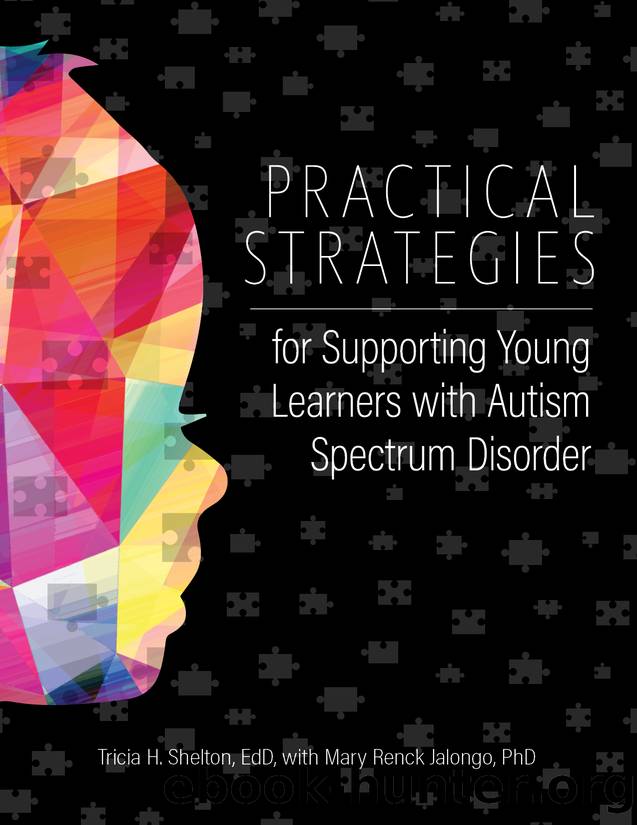Practical Strategies for Supporting Young Learners with Autism Spectrum Disorder by Shelton Tricia;Jalongo Mary Renck;

Author:Shelton, Tricia;Jalongo, Mary Renck;
Language: eng
Format: epub
Publisher: Gryphon House Inc.
Published: 2016-06-23T16:58:14+00:00
Setting Up an Engaging Environment
Students will respond differently to teaching methods, so how to best engage learners can vary from student to student. The unique characteristics of students with ASD, especially, require thoughtful planning. Although the organization of class lessons is important, teachers also must think about the type of learning environment they create for students. Because of their unique characteristics, students with ASD deserve special consideration when planning instruction.
To establish an engaging learning environment for students with ASD, librarian trainer and consultant Barbara Klipper advises taking a departure from the standard three Rs of reading, writing, and arithmetic, and instead using a different three Rs: routine, repetition, and redundancy. Students with ASD often feel more comfortable when their environment is predictable. Establishing a routine with expected activities provides this type of predictability. Repetition of task helps to create a sense of security for students and can create a level of confidence in skills as well. Further, redundancy, which many teachers may try to avoid, can actually support the learning of students with ASD. Providing multiple opportunities for students to learn and practice skills can help students with ASD better understand concepts and retain skills. The following are additional ways to offer students with ASD an engaging classroom environment.
Adapt class assignments to meet individual studentsâ needs. Provide multiple opportunities for students with ASD to follow their own learning process. Differentiate assignments so that students feel challenged, but not frustrated. Teaching a lesson on triangles, a preschool teacher might differentiate instruction by having some students trace a triangle outline, some draw the shape independently, and others sketch an example of a triangle shape found in the classroom. While planning differentiated assignments, be careful to match assignments to studentsâ needs. Be mindful that some young students with ASD may need more advanced work to be engaged in learning.
Provide choice. As often as possible, provide students with options for how they can complete assignments. Use technology, the arts, and social interaction to showcase studentsâ learning. For example, suppose you ask students to share about their favorite foods. Students can do this through a conversation, by drawing or painting, or by making a clay model. Initiate conversations about student work and pay attention to how students learn best.
Consider studentsâ learning styles. Students respond differently to different instruction. Determine how each student with ASD learns best and incorporate teaching methods that focus on that style of learning. Be creative in how you address learning styles. Integrate technology, movement, and social interaction as often as possible.
Monitor studentsâ understanding. Younger students are not always quick to say what they do not understand. This is a skill that is even more difficult for students with ASD. If students are confused by a lesson, they will become disengaged quickly. Take frequent âtemperature readingsâ of class understanding. Students can use a thumbs-up (I understand completely), a sideways thumb (I understand some, but not completely), or a thumbs-down (Iâm confused) to indicate their level of understanding.
Connect class learning to daily living.
Download
This site does not store any files on its server. We only index and link to content provided by other sites. Please contact the content providers to delete copyright contents if any and email us, we'll remove relevant links or contents immediately.
| Behavioral Disorders | Communicative Disorders |
| Gifted Students | Inclusive Education |
| Learning Disabled | Mentally Disabled |
| Physically Disabled |
The Art of Coaching Workbook by Elena Aguilar(50131)
Trainspotting by Irvine Welsh(21052)
Twilight of the Idols With the Antichrist and Ecce Homo by Friedrich Nietzsche(18312)
Fangirl by Rainbow Rowell(8808)
Periodization Training for Sports by Tudor Bompa(7937)
Change Your Questions, Change Your Life by Marilee Adams(7393)
This Is How You Lose Her by Junot Diaz(6463)
Asking the Right Questions: A Guide to Critical Thinking by M. Neil Browne & Stuart M. Keeley(5370)
Grit by Angela Duckworth(5304)
Red Sparrow by Jason Matthews(5208)
Paper Towns by Green John(4815)
Room 212 by Kate Stewart(4746)
Ken Follett - World without end by Ken Follett(4453)
The Sports Rules Book by Human Kinetics(4087)
Housekeeping by Marilynne Robinson(4075)
Double Down (Diary of a Wimpy Kid Book 11) by Jeff Kinney(3942)
Papillon (English) by Henri Charrière(3925)
The Motorcycle Diaries by Ernesto Che Guevara(3797)
Exercise Technique Manual for Resistance Training by National Strength & Conditioning Association(3791)
